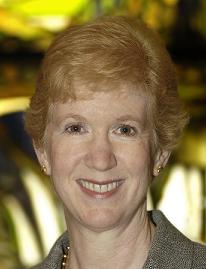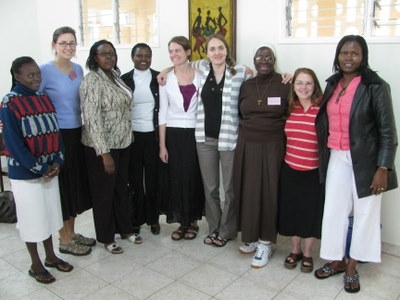| Exploring Global Feminist Theologies in a Postcolonial Space: A Learning and Research Immersion Project for Feminist Graduate Students and Post-graduates from Africa and the United States |
![PDF-NOTE: Internet Explorer Users, right click the PDF Icon and choose [save target as] if you are experiencing problems with clicking.](http://rsnonline.org/templates/rsntemplate-smallmasthead/images/pdf_button.png) |
 |
Susan A. Ross, Loyola University, Chicago, with Melissa Browning
On a Saturday afternoon in early July 2009, five American and five Kenyan women, including myself, walked out of the entrance of a former British country club in the hills surrounding Nairobi in a symbolic exit from colonial space. All of us are students of theology at stages ranging from predoctoral comprehensive exams to junior faculty to veterans of nearly thirty years in the classroom. We went to an open area a few hundred yards from the armed security gate and engaged in a ritual of song and dance. We recited the names of our foremothers, both familial and educational, and ritually enacted our new connections. After four weeks of living and studying together, the eight students and two faculty members had begun to explore similarities and differences, and the ritual was a celebration of our experiences. This project had begun two years earlier when some of my graduate students at Loyola University met to talk about how to engage other cultures in their scholarship and teaching in a way that went beyond reading or polite conversation. They began to plan for a learning experience that would help them become better teachers (and continuing learners) by engaging with students in similar circumstances in Kenya. I was drawn into the project as someone who had traveled to Kenya twice before — the first on a faculty/staff immersion trip and the second as a guest lecturer — and I worked with the students to help make their plans for a cross-cultural learning experience in Africa a reality. We wrote numerous grant proposals, most of them unsuccessful. At one point, we nearly decided to abandon the project altogether. But the AAR was the first successful grant received, and with that support, we were able to obtain more grants. The Kenyan immersion trip took place in June and July of 2009. The collaboration begun in that experience continues today, as plans for a book are ongoing and various presentations to professional conferences, both in the United States and in Africa, are in the works or have already taken place. The celebration at Brackenhurst was genuine, but the tensions of cross-cultural learning were also part of the whole experience. A week later, at one of our group sessions in a weekend devoted to assessing and concluding the experience, some of the Kenyan participants challenged the process by which the American participants wrote the grants and obtained funding before inviting the Kenyans to join. In this conference room in Amboseli National Park, surrounded by African artifacts, where morning and afternoon game drives bookended our group meetings, where a baboon challenged one of the faculty members for her banana and where we watched families of elephants move slowly across the horizon below Mount Kilimanjaro, we had an honest conversation, and politeness gave way to a difficult, painful, but necessary exchange. We came away from that conversation knowing ourselves and our new colleagues better, and determined to keep the collaboration ongoing, open, and honest.
One aspect of the program included a visit to an IDP (Internally Displaced Persons) camp in the Rift Valley area of Kenya. The people living in this camp had been displaced by the 2008 post-election violence. Their houses had been burned, their possessions stolen, and many had lost family members or had been raped during the violence. After the violence was over, the people did not feel they could go home, so they pooled their money and bought a piece of land four hours away from home. They named the camp Vumilia, which in Swahili means “to persevere.” During our service project, we spent the day listening to their stories and we asked the community what type of income-generating project they would like to create. They agreed that the community would like to raise chickens and goats. So we purchased about one hundred chickens and four goats for the community. Six months later, the chicks have multiplied. Women who were given one chick now have ten or twelve. And the community is growing. Habitat has come alongside the community to build thirty-four permanent houses. Even those who are still living in tents have set up gardens on their land and are now able to support their families. This project was important to our group because it was an exercise in listening. When we first went to the camp, we had some ideas about what type of service project we should create and how we should implement it. But when we presented our idea, it wasn’t the best fit. So we listened to how they wanted to do it. And not surprisingly, their way was a better fit. We wanted to create one community chicken project but they wanted to give everyone the option of participating in a community project or just taking their own chicken to raise. As a result, both models are now functioning in this community. Some individuals tend to their own chickens while others have pooled their resources to start a community project. This exercise in listening was an important way for us to learn how to be “activist intellectuals” (cf. Beverly Haddad) through both research and service. Since the end of the project last July, one American participant remains in East Africa (Tanzania) to conduct fieldwork for her dissertation; another completed her PhD comprehensives in the Fall and is working on her dissertation proposal. Both of these students are incorporating ethnographic fieldwork into their dissertations and both of them credit their experiences in Kenya for the importance of listening to those “on the ground” for their academic work. The two other participants from the United States are in their first and second years of tenure-track positions, negotiating their new roles as faculty members, but also drawing on their experiences in their teaching and writing. Nasimiyu will travel to the United States in June of 2010 to be on a panel presentation at the Catholic Theological Society of America’s annual meeting along with three of the participants. All eight of the student participants remain in frequent e-mail contact and are planning on a 2011 AAR presentation, with as many of the Kenyan participants joining their American counterparts as possible. We continue to support the women of the IDP camps. Along with the other members of the project — Melissa Browning, Sussy Gumo, Eunice Kamaara, Edith Kayeli, Damaris Parsitau, Emily Reimer-Barry, Elisabeth Vasko, Jeanine Viau, and Sr. Anne Nasimiyu — I am deeply grateful to the American Academy of Religion, the Wabash Center for Teaching and Learning in Theology and Religion, the Provost, Graduate Dean, and the Ann Ida Gannon Center for Women and Leadership at Loyola University, Chicago, as well as many smaller donors, who made this extraordinary experience possible. The AAR’s initial support helped to attract subsequent funding. The work begun in this project continues in many ways among all of the participants. |


 Susan A. Ross is a professor of theology and a faculty scholar at Loyola University, Chicago, where she is the chairperson of the theology department. Ross received her PhD from the University of Chicago and has taught at Saint Norbert College and Duquesne University. She is the author of For the Beauty of the Earth: Women, Sacramentality, and Justice (Paulist Press, 2006); Extravagant Affections: A Feminist Sacramental Theology (Continuum International Publishing Group, 1998); numerous journal articles and book chapters; and is the coeditor of five books and journal issues. She is a recipient of a Louisville Institute sabbatical grant, the 1999 Book of the Year award winner from the College Theology Society, and a winner of the Ann O’Hara Graff award of the Women’s Seminar of the Catholic Theological Society of America. Ross serves as vice president and member of the editorial board of Concilium: International Theological Journal. She is currently at work on Seeking Light and Beauty: A Theological Anthropology for Liturgical Press.
Susan A. Ross is a professor of theology and a faculty scholar at Loyola University, Chicago, where she is the chairperson of the theology department. Ross received her PhD from the University of Chicago and has taught at Saint Norbert College and Duquesne University. She is the author of For the Beauty of the Earth: Women, Sacramentality, and Justice (Paulist Press, 2006); Extravagant Affections: A Feminist Sacramental Theology (Continuum International Publishing Group, 1998); numerous journal articles and book chapters; and is the coeditor of five books and journal issues. She is a recipient of a Louisville Institute sabbatical grant, the 1999 Book of the Year award winner from the College Theology Society, and a winner of the Ann O’Hara Graff award of the Women’s Seminar of the Catholic Theological Society of America. Ross serves as vice president and member of the editorial board of Concilium: International Theological Journal. She is currently at work on Seeking Light and Beauty: A Theological Anthropology for Liturgical Press. The students spent four weeks at the Maryknoll Institute of African Studies at Tangaza College in Nairobi where they studied African culture, conducted fieldwork (with local field assistants), went on weekend homestays with their field assistants’ families, and negotiated the traffic and hectic life of this city of nearly three million people. My own task, as the United States-based faculty member, along with Anne Nasimiyu, professor of theology at Kenyatta University, was to support the students; but we were, in fact, all co-teachers and co-learners together.
The students spent four weeks at the Maryknoll Institute of African Studies at Tangaza College in Nairobi where they studied African culture, conducted fieldwork (with local field assistants), went on weekend homestays with their field assistants’ families, and negotiated the traffic and hectic life of this city of nearly three million people. My own task, as the United States-based faculty member, along with Anne Nasimiyu, professor of theology at Kenyatta University, was to support the students; but we were, in fact, all co-teachers and co-learners together.